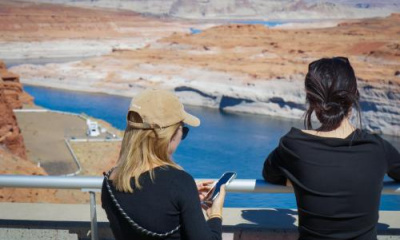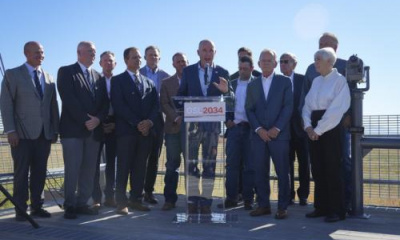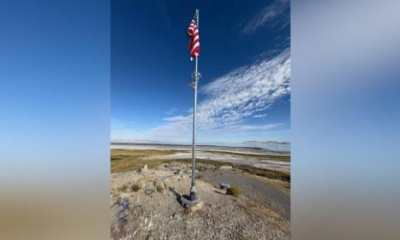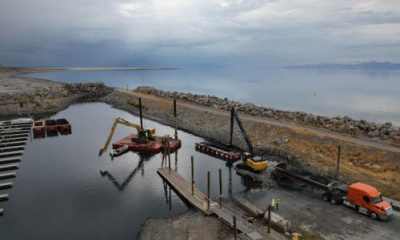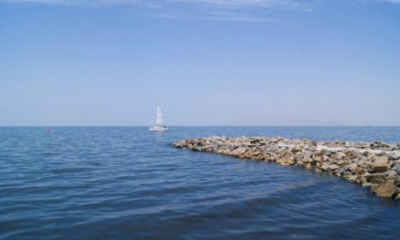Yes, they devour millions of gallons of water, recreation managers concede, but they also bring environmental, wildlife and quality-of-life benefits.
Editor’s note • This story first published on July 23, 2021. It has been updated with new data and reposted in light of Utah’s continuing water concerns and the Great Salt Lake hitting another record low.
Utah has seen yet another hot, dry summer preceded by a lot of other hot, dry summers. The Great Salt Lake hit a record low for the second year in a row. Many Utahns are surrendering on the notion of green lawns. Some municipalities are giving up on watering parks or embracing new growth.
So, is it time to give up on the idea of publicly owned golf courses, too?
Unlike a public park, golf courses appeal to a niche group of participants — predominantly white and well-off — who engage in a single activity. Only so many golfers can be on the large swaths of land at a time, and the courses are usable only under favorable weather conditions. And all those greens, fairways and tee boxes gobble up a mind-boggling amount of water.
“People are starting to look at the issue, especially with climate change,” said Alessandro Rigolon, an assistant professor of city and metropolitan planning at the University of Utah, whose research focuses on green space and environmental justice. “Golf courses are not sustainable now, and it’s going to probably get worse.”
Salt Lake County taps by far the most water for its golf courses, which include a mix of publicly owned and privately held lands, compared to other counties in the state, topping even arid Washington County, home of sunny St. George. According to U.S. Geological Survey data for 2015, the most recent year with available information, Salt Lake County golf courses used a whopping 9 million gallons a day of groundwater and surface water. To put that in perspective, it’s like refilling nearly 14 Olympic-size swimming pools daily.
“We’re trying to do everything we can [to conserve] because we are cognizant of the fact that we are big water users” said Jerry Brewster, director of golf for Salt Lake County. “We absolutely use water.”
Why golf courses can’t stop watering altogether
While the USGS information about golf course irrigation in Salt Lake County is several years old, it’s hard to gather updated data. A public records request sent to the county’s Parks and Recreation personnel in 2022 produced three years’ worth of irrigation numbers, with figures that didn’t all match information the county shared in 2021.
The consumption rates also swing wildly from year to year. In 2019, the county reported 659 million total gallons used between its six courses. That figured jumped to 827.7 million in 2020, then sank back down again to 663 million gallons in 2021. That’s enough water to support about 10,750 Utahns.
Mountain View Golf Course consistently gulps the most water, averaging 185 million gallons a year over the past three seasons. That’s about 1.3 million gallons per acre.
Brewster noted in an interview in 2021 that the county uses technology like smart irrigation and wetting agents to cut down water consumption.
“We live in a high desert,” he said, “so we’ve been anticipating this and thinking about it and trying to plan ahead as much as possible.”
But, golf managers point out, they can’t stop watering entirely. Public courses don’t rely on taxpayer funds — they have separate budgets, generating their own money from players. They need those players to visit the courses to stay afloat. In short, green greens generate greenbacks.
“Our primary feature of the golf course, the green, and how the ball rolls and putts, is the one area where people judge how your golf course is,” Matt Kammeyer, director of Salt Lake City’s golf division, said in a 2021 interview as he worked to reduce irrigation at the city’s six courses by 5%. “If you’re playing off just dirt, people aren’t going to pay to come out.”
And letting turf die ultimately could be extraordinarily expensive. Salt Lake City officially abandoned its Wingpointe Golf Course in 2017 due partly to the cost of reviving it — estimated at $1 million.
“If you get to a point where it dies, then you have to do one of two things,” Brewster said. “You have to reseed it, or you have to sod it ... and you’re going to use 10 times the amount of water to reestablish the root structure.”
The pluses and minuses of golf courses
Operators of publicly owned golf courses in Salt Lake County point to the benefits of their facilities.
“The beautiful thing that we do is we provide golf at an affordable rate,” Brewster said. “We aren’t country clubs. We aren’t high-end daily fee facilities. We’re not resort golf courses.”
Large tracts of green space like golf courses also provide environmental pluses in a county full of dense urban development.
“We provide riparian habitat,” Brewster said. “We have animals and birds.”
Rigolon acknowledged that having a large area of irrigated turf is preferable to asphalt or concrete. Grass has a cooling effect on hot days, prevents erosion and helps filter stormwater. Golf courses also tend to have large trees and other natural features that provide benefits to surrounding residents, even if they never pick up a 9-iron.
But, he said, unlike a park, which can serve as an inclusive gathering space and a bridge from one neighborhood to the next, golf courses act more like “green walls.”
“They are almost gated. And in some places there are actual fences,” Rigolon said. “The function and public they serve is more exclusionary than other green spaces ... which is contrary to what you would think public land would be.”
Municipalities throughout the nation have reimagined and repurposed golf courses into more inclusive spaces. Grafton, Ohio, has converted a former golf course into a nature preserve.
Some lawmakers have floated the idea of building affordable housing on sprawling golf courses, with a communal park at the center.
“With golf courses, there are some community benefits,” Rigolon said. “But especially in places like Salt Lake or other places where the real estate is so expensive and people are craving outdoor activities, the community benefits could be so much more.”
A pandemic bounce
Blame it on the sport’s perceived elitism, blame it on changing recreation trends, blame it on millennials, but golf participation has seen a slow and steady decline through the years, both nationwide and in Salt Lake County.
In the United States, there were 6.8 million fewer golfers in 2018 versus 2003, and 800 courses closed in the past decade, leading to chatter about how to repurpose the open spaces.
Then the pandemic hit.
“I’ve not seen an increase in one year this substantial,” Kammeyer said.
The city’s courses saw a 25% jump in participation in 2020 compared to the previous five-year average.
“That’s significant,” Kammeyer said. “It’s not just Salt Lake City, all of the golf industry has experienced a similar boost.”
Golf was one of the first outdoor recreation activities that was able to safely reopen during public health closures — in Salt Lake City’s case, the golf courses never closed.
“One of the things that the pandemic showed us is how much of a community service that golf is,” Brewster said. “We saw unprecedented numbers of people that went to the golf course because it was all they could do.”
The county’s six golf courses saw participation swell from 316,201 in 2019 to 392,597 in 2021.
The industry measures “participation” as the number of nine-hole rounds, so it’s unclear if the gains came from the same golfers having more free time to play multiple rounds or if the pandemic spurred more players to take up the sport.
“It’s good to see people are still wanting to get out and play,” Kammeyer said.
Reimagining golf spaces
The spike in participation could make it difficult to sell the idea of converting golf courses into more inclusive, water-wise spaces. But Rigolon said the movement doesn’t need to be a revolution.
“It doesn’t mean that we shut them down,” the professor said. “It means that maybe we start with some gradual changes.”
He suggested adding protected pathways for walkers and cyclists. Or building playgrounds. Maybe we need more nine-hole courses and fewer 18-hole facilities.
“Soccer is a growing sport, especially among minorities,” Rigolon said. “Why not take in a little bit of the golf course, and turn it into some soccer fields, especially on the west side?”
Salt Lake City is already exploring the idea of repurposing sections of golf courses, or adding amenities that appeal to nongolfers, through its “Reimagine Nature” public lands master planning process. Ideas include re-wilding unplayable sections, adding concessions and accommodating new activities like cross-country skiing, disc golf and off-leash dog areas.
While rethinking golf spaces is likely to meet some resistance, Rigolon said the fact that the conversation is even happening gives him hope.
“If you ask me personally, the best time to start was yesterday,” Rigolon said, “and the second best is now.”



